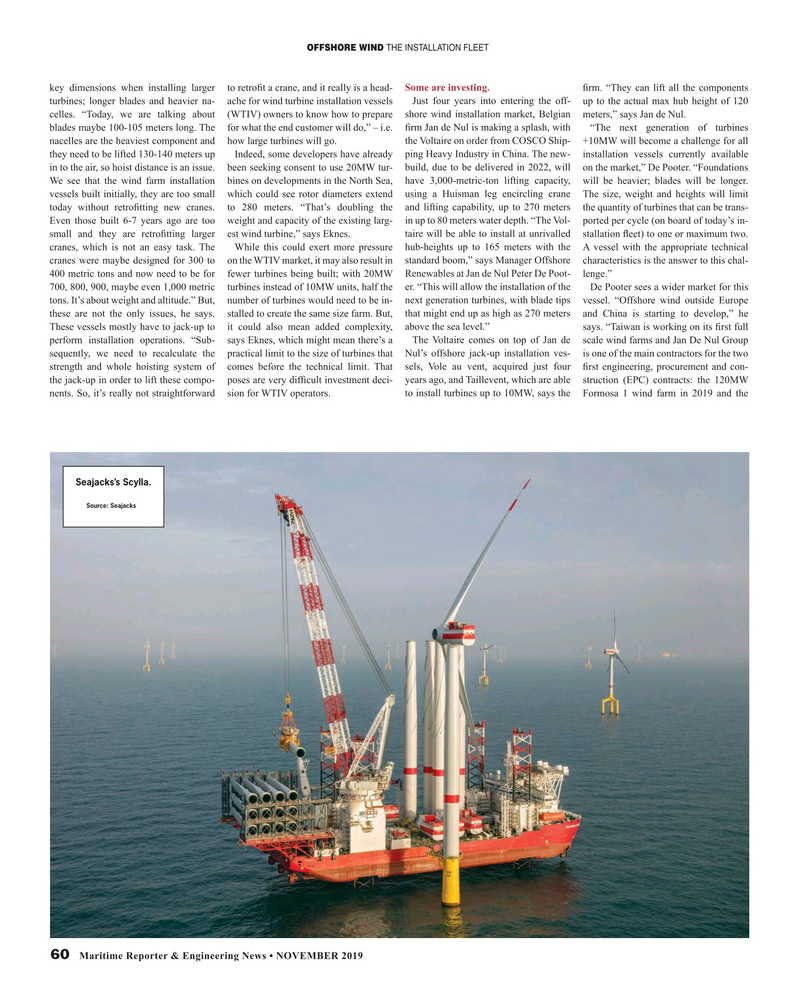
Page 60: of Maritime Reporter Magazine (November 2019)
Workboat Edition
Read this page in Pdf, Flash or Html5 edition of November 2019 Maritime Reporter Magazine
OFFSHORE WIND THE INSTALLATION FLEET key dimensions when installing larger to retro? t a crane, and it really is a head- Some are investing. ? rm. “They can lift all the components turbines; longer blades and heavier na- ache for wind turbine installation vessels Just four years into entering the off- up to the actual max hub height of 120 celles. “Today, we are talking about (WTIV) owners to know how to prepare shore wind installation market, Belgian meters,” says Jan de Nul. blades maybe 100-105 meters long. The for what the end customer will do,” – i.e. ? rm Jan de Nul is making a splash, with “The next generation of turbines nacelles are the heaviest component and how large turbines will go. the Voltaire on order from COSCO Ship- +10MW will become a challenge for all they need to be lifted 130-140 meters up Indeed, some developers have already ping Heavy Industry in China. The new- installation vessels currently available in to the air, so hoist distance is an issue. been seeking consent to use 20MW tur- build, due to be delivered in 2022, will on the market,” De Pooter. “Foundations
We see that the wind farm installation bines on developments in the North Sea, have 3,000-metric-ton lifting capacity, will be heavier; blades will be longer. vessels built initially, they are too small which could see rotor diameters extend using a Huisman leg encircling crane The size, weight and heights will limit today without retro? tting new cranes. to 280 meters. “That’s doubling the and lifting capability, up to 270 meters the quantity of turbines that can be trans-
Even those built 6-7 years ago are too weight and capacity of the existing larg- in up to 80 meters water depth. “The Vol- ported per cycle (on board of today’s in- small and they are retro? tting larger est wind turbine,” says Eknes. taire will be able to install at unrivalled stallation ? eet) to one or maximum two. cranes, which is not an easy task. The While this could exert more pressure hub-heights up to 165 meters with the A vessel with the appropriate technical cranes were maybe designed for 300 to on the WTIV market, it may also result in standard boom,” says Manager Offshore characteristics is the answer to this chal- 400 metric tons and now need to be for fewer turbines being built; with 20MW Renewables at Jan de Nul Peter De Poot- lenge.” 700, 800, 900, maybe even 1,000 metric turbines instead of 10MW units, half the er. “This will allow the installation of the De Pooter sees a wider market for this tons. It’s about weight and altitude.” But, number of turbines would need to be in- next generation turbines, with blade tips vessel. “Offshore wind outside Europe these are not the only issues, he says. stalled to create the same size farm. But, that might end up as high as 270 meters and China is starting to develop,” he
These vessels mostly have to jack-up to it could also mean added complexity, above the sea level.” says. “Taiwan is working on its ? rst full perform installation operations. “Sub- says Eknes, which might mean there’s a The Voltaire comes on top of Jan de scale wind farms and Jan De Nul Group sequently, we need to recalculate the practical limit to the size of turbines that Nul’s offshore jack-up installation ves- is one of the main contractors for the two strength and whole hoisting system of comes before the technical limit. That sels, Vole au vent, acquired just four ? rst engineering, procurement and con- the jack-up in order to lift these compo- poses are very dif? cult investment deci- years ago, and Taillevent, which are able struction (EPC) contracts: the 120MW nents. So, it’s really not straightforward sion for WTIV operators. to install turbines up to 10MW, says the Formosa 1 wind farm in 2019 and the
Seajacks’s Scylla.
Source: Seajacks 60 Maritime Reporter & Engineering News • NOVEMBER 2019
MR #11 (59-65).indd 60 10/29/2019 11:32:37 AM

 59
59

 61
61
